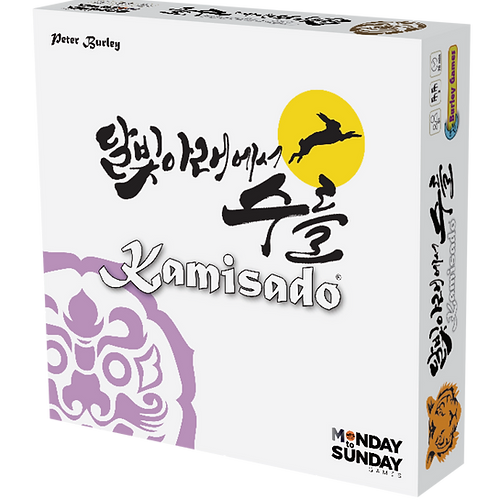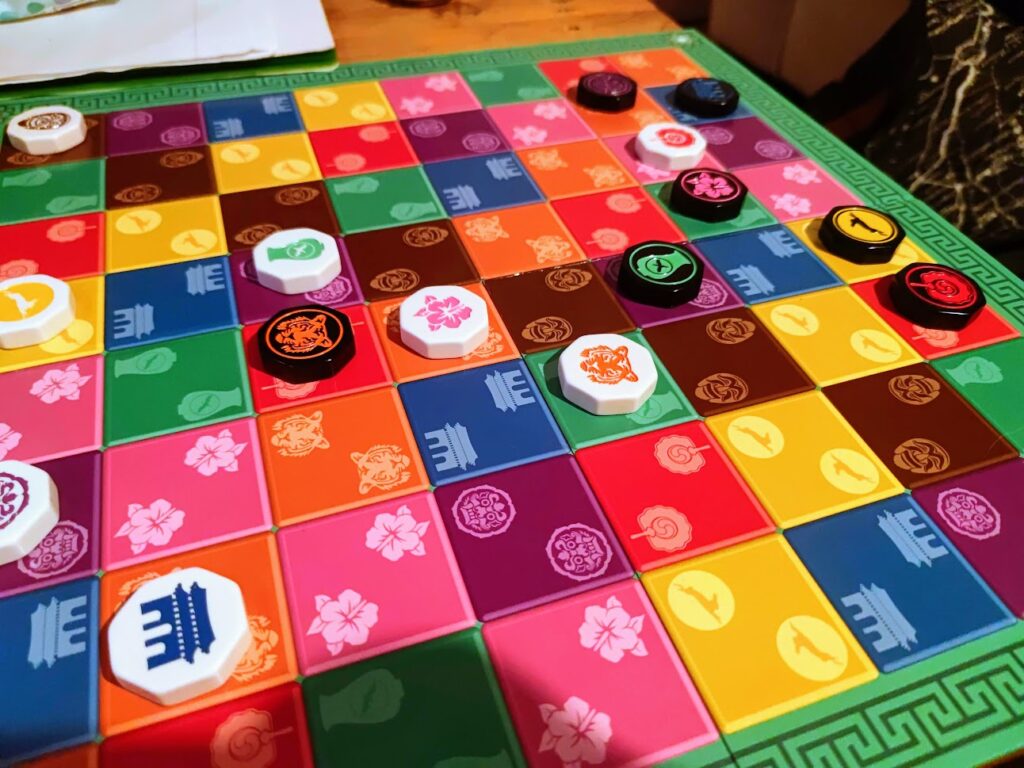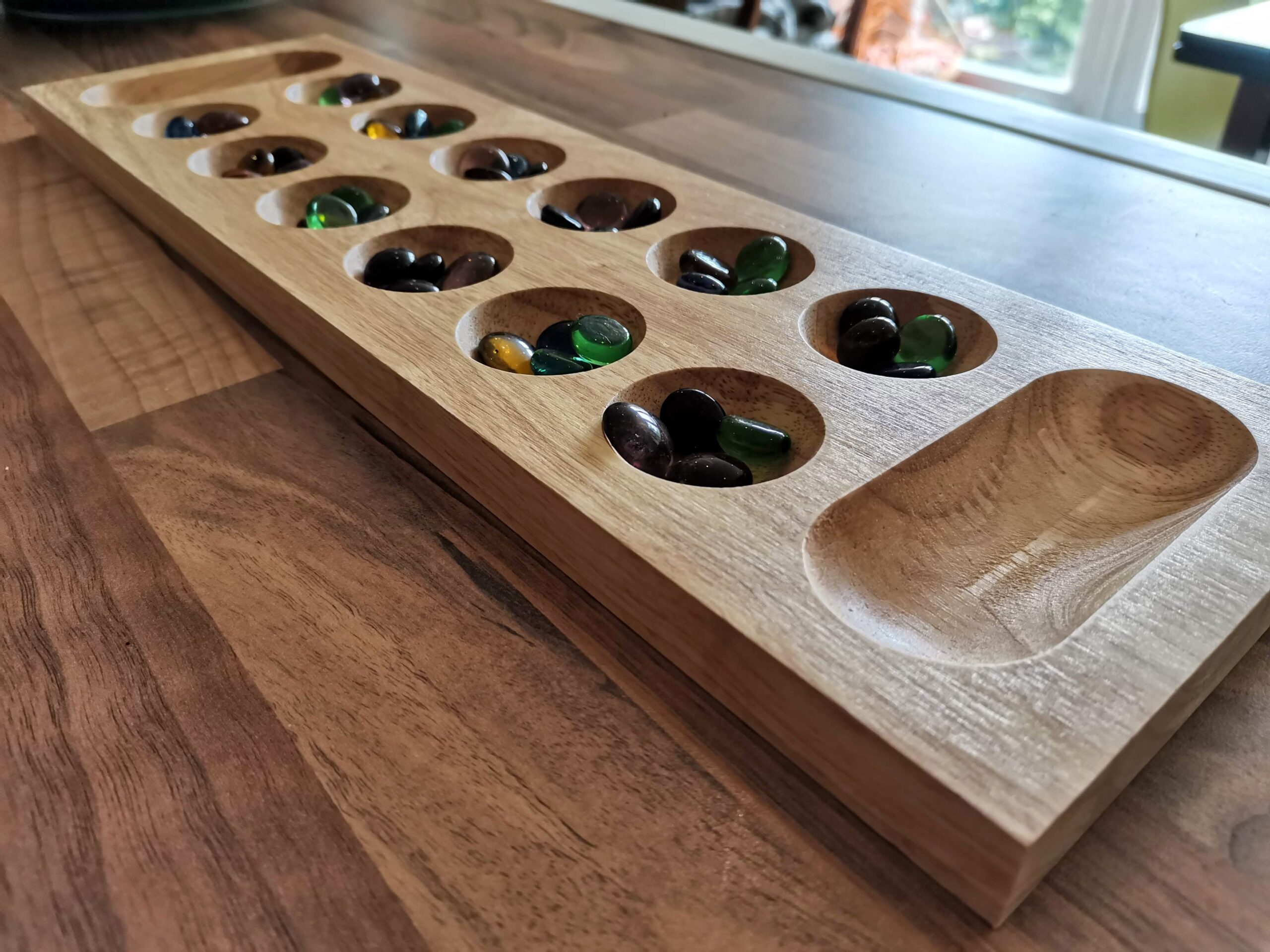Kamisado Review

Abstract games are a real mixed bag. Some are brain-meltingly tactical and considered, some are light and simplistic. Kamisado finds a happy medium between the two extremes. It’s a game I can teach to anyone in a minute and have them enjoy, but the depth of the strategy continues to emerge long after your fiftieth game. The joy of the game comes from the fact that each game is so fast, and so much fun. It never feels like a study, and that’s what I love about it. Kamisado is a wonderful experience.
For reference, I played the recently-released Korean edition of Kamisado, which might be different to the version you’ve seen or played.
I remember when I got into modern board games 15 years ago, one of the first games I picked up was Hive. It was a revelation to me because I hadn’t played a ‘new’ abstract game, and my experience was limited to games like Draughts, Chess, and Chinese Checkers – all of the standard games people of my age grew up playing. I didn’t realise that people still made new abstract games. From there it led to those games with their names all in capitals: GIPF, DVONN, YINSH. All of them are great games, but they were difficult to relate to non-gamers in the sense of not being able to say “It’s a bit like…”.
Chess? Draughts? Kinda, but not quite
When you look at the Kamisado board it’s obvious that colour plays a big part in the game. It’s not just for the sake of looking pretty. The colours of the squares and the colours of the playing pieces are intrinsically linked. To explain why I need to tell you how the game works, and being able to explain how to play so easily is the game’s greatest strength – its low barrier to entry.
Each of your pieces can move forwards in a straight line, or on a 45-degree diagonal. They can move as far as you like, as long as they don’t move through another piece. Whatever colour square you land on dictates which piece your opponent has to move. For instance, if my piece lands on a red square, you have to move your red piece. If either player gets one of their pieces to their opponent’s side of the board, they win.
That’s it, that’s the whole game of Kamisado explained. It’s that simplicity which makes it so good though. I taught my son how to play it in a couple of minutes, we played a full game in less than five minutes, and then we played again. And again. And again. You get the idea. It’s so immediately engaging and so addictive. It’s a genius piece of game design on the part of Peter Burley. It feels like Draughts on Speed meets the French Military Game (Hare and Hounds if you’ve played Nintendo’s 51 Worldwide Games). It’s a game of simultaneously trying to hold your line while breaking your opponent’s. I love watching Rugby, and it reminds me of that.
Lasting appeal
There’s plenty to keep Kamisado from gathering dust on your shelves. The most obvious thing is the full game, whereby a tile that wins a round gets flipped to a side with a ring around it. These are Sumo pieces, which can only move five spaces, but can shunt pieces directly in front of them. Get three Sumos, you win, or get one Sumo to the other side, you also win.

There’s something about playing the game which just feels good. Each time you move it feels really powerful to be able to slide right the way across the board in one move. This feeling of power is tempered somewhat by the inevitable “Oh no, I can’t go backwards now!” realisation that comes afterwards, but it’s a lot of fun regardless. There’s another nice touch in the box in the form of numbered tiles, which, when drawn, give you alternate setups in the rulebook. It’s only a small thing, but it keeps the game fresh, which is important in a game which can be played 15+ times in an hour.
Final thoughts
Kamisado is a fantastic game. It’s a game I could buy as a gift for anyone, and know they could get have a lot of fun with it. In a hobby as niche as tabletop games can be, this level of universal appeal is pretty unique. I’ve always seen the little castle-shaped pieces in the older versions of Kamisado, but I’ve got to say that I think I prefer the bakelite tiles that come with the Korean version. The inlaid icons are clean and colourful, and they have that same wonderful ‘clack’ as the pieces in games like Hive, Mahjong or Bananagrams.
The icons on the board and pieces mean that it’s a game which works with any type of colour blindness too, which is great. Anything which keeps our hobby accessible is a good thing. The rulebook seems unnecessarily long when you open the box. In reality, you only need about 10% of the book to learn how to play though, the rest is set up scenarios and details of how to play in competitive situations.
Put simply, Kamisado is my favourite abstract game. The presentation, ease of learning, depth of strategy, and table presence all add up to a wonderful game. If you can get it (which you can in the UK from Burley Games direct), you should get the Korean version. The artwork and presentation are beautiful, and there’s something about the flat, squat tiles which is almost unbearably tactile. What a wonderful game, and one I have no hesitation in recommending.
Review copy kindly provided by Burley Games. Thoughts and opinions are my own.

Kamisado (2008)
Designer: Peter Burley
Publisher: Burley Games
Art: Peter Dennis, Steve Tolley
Players: 2
Playing time: 15 mins













